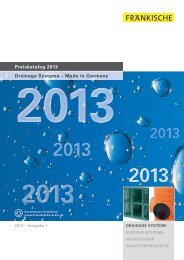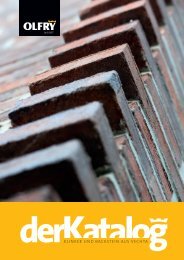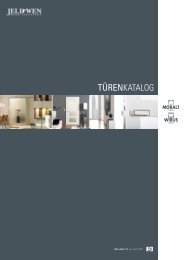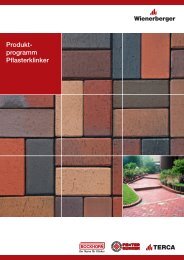new - Produkte24.com
new - Produkte24.com
new - Produkte24.com
Sie wollen auch ein ePaper? Erhöhen Sie die Reichweite Ihrer Titel.
YUMPU macht aus Druck-PDFs automatisch weboptimierte ePaper, die Google liebt.
GBTECHNICAL INFORMATION<br />
Klassen<br />
· unglasiert: ULA/ULB/ULC bzw. UHA/UHB/UHC*<br />
· glasiert: GLA/GLB/GLC bzw. GHA/GHB/GHC*<br />
* Klasse A höchste Beständigkeit nach C abnehmend<br />
Fleckbeständigkeit gemäß EN ISO 10545-14 Fleckenbildner<br />
· Spurenbildende Fleckenbildner; grüne Fleckenbildner in Öl; rote<br />
Fleckenbildner in Öl; Fleckenbildner chemisch; Jod, 13g/l in<br />
Alkohol; Filmbildende Fleckenbildner, Olivenöl<br />
Reinigung<br />
· Reinigungsmittel: Heißes Wasser (+55 °C), schwaches<br />
Reinigungsmittel, starkes Reinigungsmittel<br />
· Lösungsmittel: Salzsäurelösung 3%; Kaliumhydroxid 200g/l; Aceton<br />
Klassen: 5/4/3/2/1*<br />
Blei- und Cadmiumabgabe<br />
Die glasierten Oberflächen werden einer Essigsäure-Lösung ausgesetzt.<br />
Anschließend wird die Menge des abgegebenen Bleis und<br />
Cadmiums bestimmt.<br />
* Klasse 5 weist die höchste Fleckbeständigkeit auf, nach Klasse 1<br />
abnehmend<br />
Rutschhemmung/Trittsicherheit<br />
Gemäß BGR 181 (Berufsgenossenschaftliche Regel) dürfen in Arbeitsräumen<br />
und in öffentlichen Einrichtungen nur Fußböden verlegt werden,<br />
die abhängig von der jeweiligen Rutschgefahr nach einer festgelegten<br />
Rutschhemmungsgruppe klassifiziert sind. Der R-Wert eines Bodenbelags<br />
kennzeichnet den Grad der Rutschhemmung und wird bei dem Be -<br />
gehungsverfahren nach DIN 51130 ermittelt. Danach richtet sich die<br />
Einordnung in eine der fünf Bewertungsgruppen von R 9 bis R 13.<br />
Bodenbeläge mit der Bewertungsgruppe R 9 genügen den geringsten<br />
Anforderungen, Bodenbeläge mit der Bewertungsgruppe R 13 den<br />
höchsten Anforderungen. Eine Tabelle mit den Einsatzbereichen für<br />
die vorgeschriebenen Rutschhemmungsgruppen finden Sie unter<br />
www.hvbg.de<br />
Reinigung von Bodenfliesen<br />
Bei der Reinigung von keramischen Bodenbelägen unterscheidet man<br />
Erst-/Grundreinigung und laufende Unterhaltsreinigung:<br />
1. Erst-/Grundreinigung<br />
Die Erst- bzw. Grundreinigung erfolgt nach Abschluss der Verlegearbeiten<br />
und gehört zum Arbeitsumfang des Fliesenlegers. Durch diese Reinigung<br />
werden Rückstände der Verlegearbeiten (Fugenmaterial, Klebstoff,<br />
Baustellenschmutz) entfernt sowie Rückstände auf der Materialoberfläche<br />
beseitigt. Häufig sind spätere Reinigungsprobleme auf mangelhafte<br />
oder fehlende Grundreinigung zurückzuführen. Wir empfehlen die<br />
vom Fliesenleger verwendeten, speziell für diesen Bereich vorge sehenen<br />
Reinigungsmittel. Vor der Verarbeitung der Reinigungsmittel müssen<br />
unbe dingt die Beständigkeit der zu reinigenden Oberfläche geprüft<br />
und die Hinweise des Herstellers der Reinigungsmittel beachtet werden.<br />
2. Laufende Unterhaltsreinigung<br />
Flüssigkeiten, die Farbstoffe enthalten, Öle und Fette können bei unglasierten<br />
Fliesen Flecken hinterlassen. Um hier vorzubeugen, wird die<br />
Verwendung handelsüblicher Versiegelungsmittel empfohlen. Der Fliesenleger<br />
sollte den Fliesenbelag nach der Grundreinigung, aber vor der<br />
Inanspruchnahme entsprechend behandeln. Für die Reinigung der Fliesen<br />
vom normalen Straßenschmutz wird die Verwendung von Wasser<br />
empfohlen. Auf jeden Fall sollte auf den Einsatz filmbildender Reinigungsmittel<br />
verzichtet werden.<br />
Calibration and rectification<br />
Rectified tiles are carefully reworked to size. Because they are calibrated,<br />
all long and short sides are cut to a uniform size. After rectification,<br />
all of the tiles are remeasured. Products that then show<br />
curvature or a deviation in size are sorted out. This finishing process<br />
offers two advantages: thanks to the exact form, rectified tiles can<br />
be installed with nearly invisible joints and all tiles are delivered with<br />
the same size. This means it is no problem for Steuler-Fliesen to<br />
offer combinations of various colours and series.<br />
Surface quality<br />
First Quality: Porcelain Sto<strong>new</strong>are. Tiles by Steuler-Fliesen meet the<br />
requirements of EN 14411 and are suitable for use indoors and outdoors<br />
as well as under changing weather conditions. Taking into account<br />
the recommendations stated in this catalogue with regard to the<br />
area of application, Steuler-Fliesen guarantees resistance to abrasion<br />
and scratching. Tiles that are marked “1st Quality” are free from crazing<br />
or cracking and visible flaws that detract from the appearance<br />
of a large tiled surface. Seconds: Tiles that fail to meet the requirements<br />
for classification as 1st Quality are declared to be seconds and<br />
thus do not comply with the provisions of EN 14411.<br />
Cleaning and care<br />
Cleaning after laying removes general residue (mortar, adhesive,<br />
paint, all kinds of building-site dirt) and eliminates surface residue.<br />
Subsequent cleaning problems can often be attributed to poor or<br />
non-existent basic cleaning.<br />
Before treating with cleaning agents, please test whether the<br />
surface to be cleaned is resistant to the cleaning agent.<br />
Water absorbtion/frost resistance<br />
Tiles intended for installation outdoors must be frost proof. The prerequisite<br />
for this is low water absorption. Frost-resistance is tested in<br />
accordance with EN 10545-12 in a specified freeze/thaw cycle.<br />
Water absorption in detail is governed by the inspection and testing<br />
standard EN 10545-3. The process stipulates the relationship be -<br />
tween the weight of the dry sample and the weight including the<br />
water absorbed as a percentagee. All of the Steuler-Fliesen articles<br />
contained in this catalogue have been classified as frost proof after this<br />
test due to minimal water absorption.<br />
Slip resistance/Anti-skid protection in barefoot areas<br />
The surface properties of ceramic floor tiles noticeably influence<br />
safety of movement. Slip resistance is evaluated according to a series<br />
of standards and defined methods:<br />
DIN 51097: Determination of slip resistance for wet surfaces in<br />
barefoot areas<br />
DIN 51130: Determination of slip resistance for work rooms and<br />
working areas with increased risk of skidding.<br />
In accordance with DIN 51130, floor tiles are categorised in groups<br />
designated R10 through R 13.<br />
· R9: Group slip angle 6 – 10°<br />
· R10: Group slip angle 10 – 19°: Ceramic floor tiles, e. g., in storerooms,<br />
small kitchens<br />
· R11: Group slip angle 19 – 27°: Ceramic floor tiles, e. g., in<br />
kitchens, sanatoriums, car washes, laundries, grinding shops<br />
· R12: Group slip angle 27 – 35°: Ceramic floor tiles, e. g., in meat<br />
processing areas, industrial kitchens, dairies<br />
· R13: Group slip angle > 35°: Ceramic floor tiles, e. g., for floors in<br />
slaughterhouses, oil refineries, tanneries.<br />
In many areas, demands with regard to slip resistance are especially<br />
high. What is evaluated is the ability of a relieftype surface to divert<br />
or displace a given quantity of fluid. This property is determined in<br />
accordance with Standard 51130. What is decisive is the volume<br />
of indentations in the surface and the so-called drainage space,<br />
expressed by the letter “V” and a corresponding number (e.g., V 4).<br />
In accordance with DIN 51097, floor tiles are categorised in groups<br />
designated by the letters A, B, and C.<br />
A Group slip angle 12°: Barefoot walking (largely dry): Individual<br />
and group changing rooms; pool floors in non-swimmer areas, if the<br />
water depth in the entire area exceeds 80 cm; sauna and rest areas<br />
(largely dry)<br />
B Group slip angle 18°: Barefoot walking, unless allocated to “A”;<br />
Shower areas; disinfection spray system areas; walking areas<br />
around pools; pool floors in the non-swimmer area if the water depth<br />
in parts of the area is less than 80 cm; pool floors in the non-swimmers<br />
area of swimming pools with wave machines; adjustable<br />
height pool floors; wading pools; ladders leading into the water;<br />
stairs leading into the water with a max. width of 1 m and railings<br />
on both sides; ladders and stairs outside of the pool area; sauna and<br />
rest areas, provided they are not allocated to “A”<br />
C Group slip angle 24°: Steps leading into the water, unless they<br />
are allocated to “B”; walk-through pools; slanted pool walls<br />
Abrasion<br />
For glazed tiles, resistance to surface abrasion is stated in terms of<br />
PEI 1 – 5. In accordance with test standard EN 10545- 7, resistance<br />
to surface abrasion is determined in a PEI wet test. Artificial abrasion<br />
can be created using aluminium oxide particles, steel shot and water<br />
set in an eccentric circular motion. The number of rotations and the<br />
visible abrasion of the surface serve as a measure for classification in<br />
the following stress groups:<br />
Stress group I: Glazed ceramic floor coverings that can be walked<br />
on with soft-soled shoes in low-traffic areas without especially abra -<br />
sive dirt. Use in bathrooms, bedrooms in dwellings without direct<br />
access from outside.<br />
Stress group II: Glazed ceramic floor coverings which can be<br />
walked on with normal shoes in low-traffic areas with low levels of<br />
abrasive dirt. Use in domestic areas except for kitchens, hallways,<br />
and other high-traffic areas.<br />
Stress group III: Glazed ceramic floor coverings which can be<br />
walked on with normal shoes in medium-traffic areas with low levels<br />
of abrasive dirt. Use throughout residential areas, balconies, loggias,<br />
hotel bathrooms.<br />
Stress group IV: Glazed ceramic floor coverings that can be stressed<br />
more intensively in terms of frequency of soiling and use with<br />
normal shoes in high-traffic areas. Use in entryways, salesrooms<br />
and working areas, offices.<br />
Stress group V: Glazed ceramic floor coverings that are exposed to a<br />
high level of wear in high-traffic areas. Use in restaurants, bar and<br />
counter areas, garages.<br />
151 / 2012






